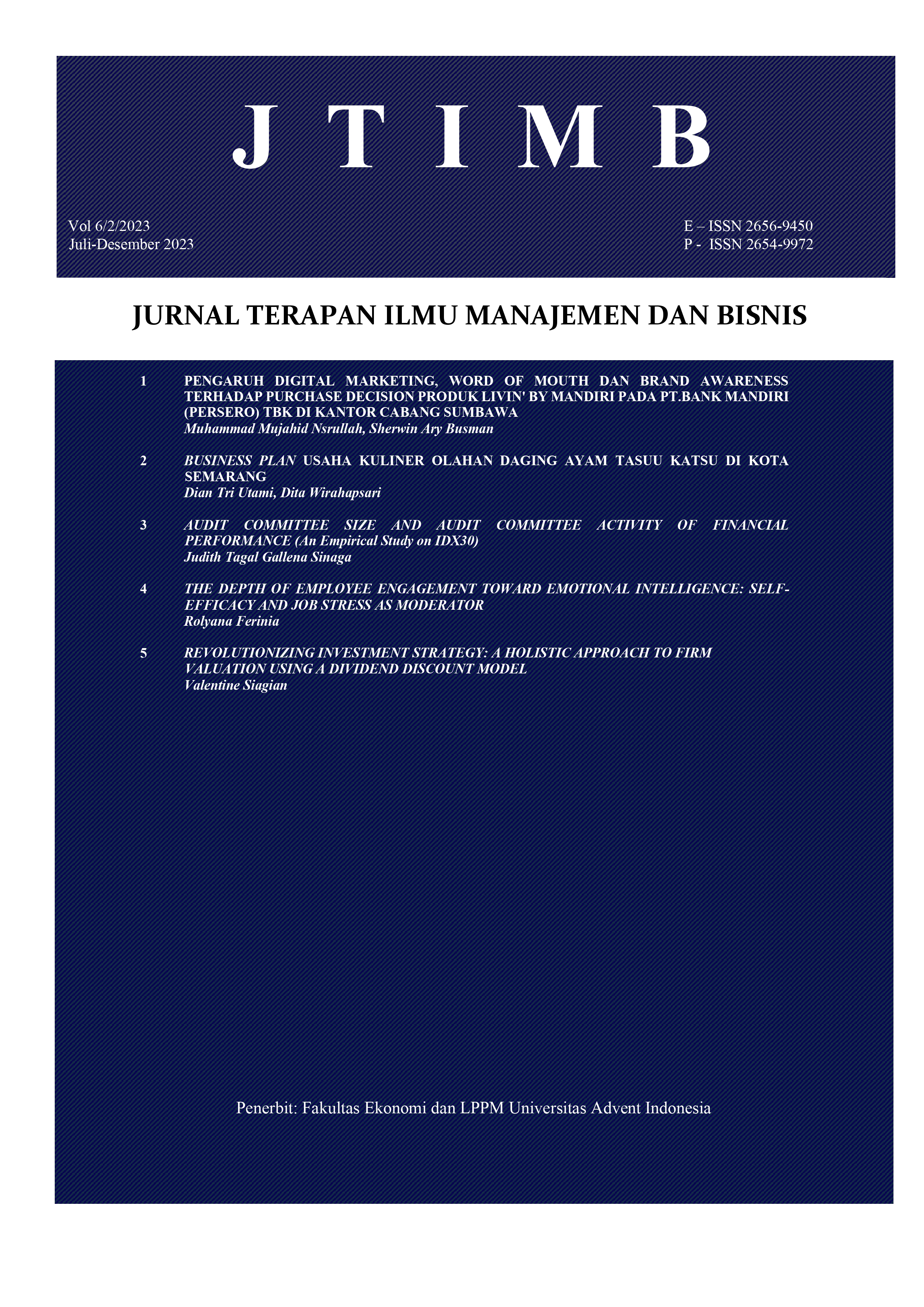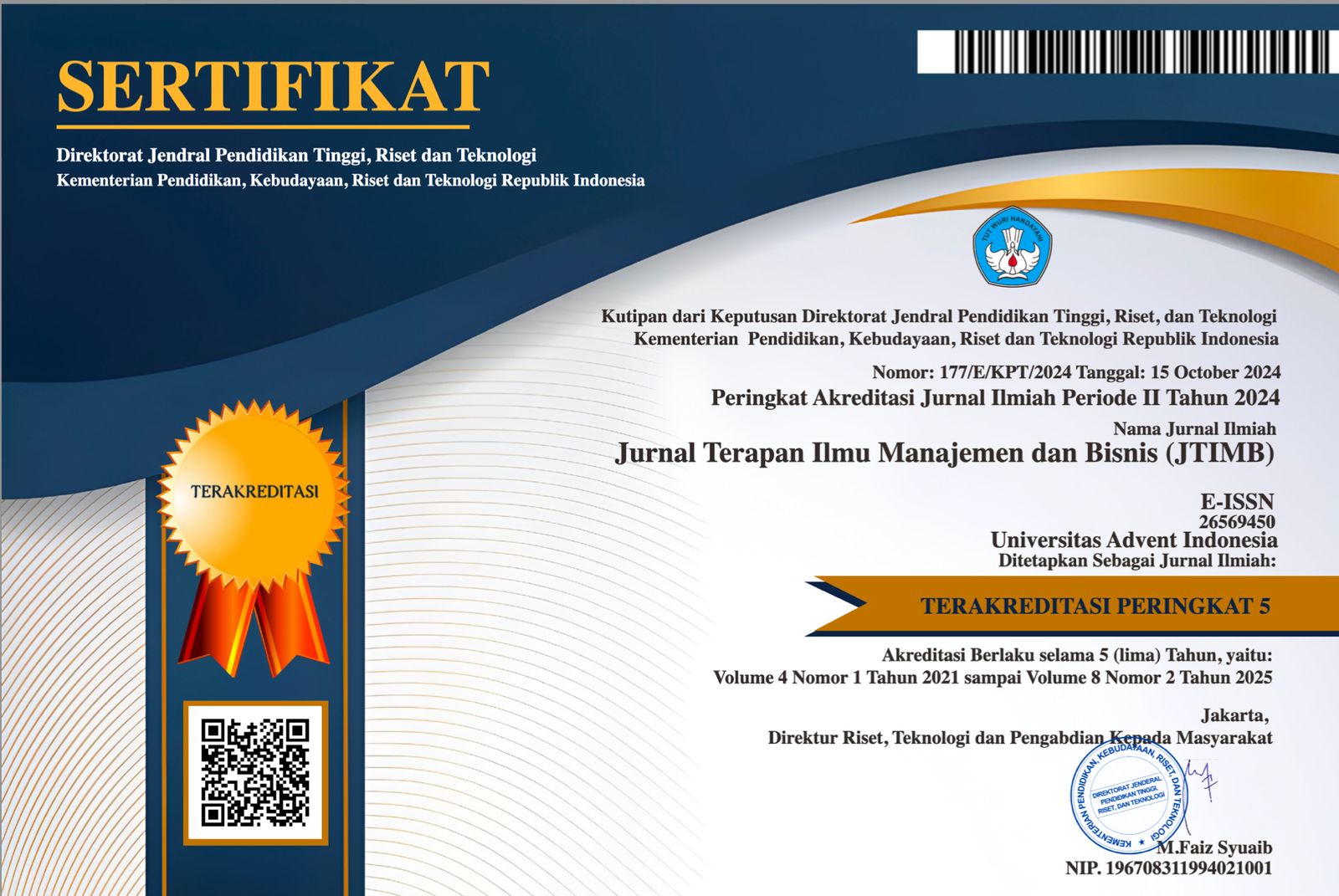The Depth of Employee Engagement Toward Emotional Intelligence: Self-Efficacy and Job Stress as Moderator
Kata Kunci:
Emotional Intelligence, Job Stress, Self-Efficacy, Employee EngagementAbstrak
This study tries explore to the elements influencing employee engagement optimization.This study aimed to investigate how employee engagement influences emotional intelligence mediated by self-efficacy and job stress. An explanatory causal approach was used to test hypotheses on 320 employees, where data were analyzed using PLS-SEM. The main findings show that employee engagement and job stress are significantly influenced by emotional intelligence through self-efficacy. Emotional intelligence and self-efficacy proven to have a strong connection with minimizing job stress. Additionally, self-efficacy is highly influenced in optimizing employee engagement. This study contributes to organizational behavior, human resources, and psychology field by investigating employee emotional intelligence, workplace attitudes, and stress that needs to be anticipated to engage employees. This is one of the few studies on how self-efficacy and job stress affect emotional intelligence and employee engagement. It provides an opportunity to improve and develop human resources by optimizing employee engagement through emotional intelligence, fostering self-efficacy, and reducing workplace stress factors.
Referensi
Abdel-Khalek, A. M. (2016). Introduction to the Psychology of self-esteem. In Self-esteem: perspectives, influences, and improvement strategies. (Issue January). Nova Science Publisher.
Abu Shanab, E., & AbuShanab, A. (2022). The Influence of Emotional Intelligence on Technology Adoption and Decision-Making Process. International Journal of Applied Decision Sciences, 1(1), 1. https://doi.org/10.1504/ijads.2022.10041125
ADP Research Institute. (2011). Employee Satisfaction vs. Employee Engagement: Are They the Same Thing?
Albrecht, S. (2010). Handbook of Employee Engagement.
Amstrong, M. (2008). Strategic Human Resources Management (4th ed.). Kogan Page Limited.
Ancol Korporat. (2020). 5 Program Utama CSR Ancol | Neraca. https://korporat.ancol.com/id/page/program-csr
Badura, A. (1997). Self-Efficacy: The Exercise of Control. W.H. Freeman and Company.
Basile, D. M., & Mackenzie, M. L. (2012). Emotional Intelligence Explored within Top US Companies. Proceedings of the Northeast Business & Economics Association, 2–6. https://search.ebscohost.com/login.aspx?direct=true&db=buh&AN=121051472&site=ehost-live
Boyatzis, R. E. (1982). The competent manager: A model for effective performance. Wiley.
Carr, J., Kelley, B., Keaton, R., & Albrecht, C. (2011). Getting to grips with stress in the workplace: Strategies for promoting a healthier, more productive environment. Human Resource Management International Digest, 19(4), 32–38. https://doi.org/10.1108/09670731111140748
Caruso, D. R., & Salovey, P. (2004). The Emotionally Intelligent Manager. Jossey-Bass Publishers.
Cobb, C. D., & Mayer, J. D. (2000). Emotional intelligence. In Educational Leadership (Vol. 58, Issue 3, pp. 14–18).
Consiglio, C., Borgogni, L., di Tecco, C., & Schaufeli, W. B. (2016). What makes employees engaged with their work? The role of self-efficacy and employee’s perceptions of social context over time. Career Development International, 21(2), 125–143. https://doi.org/10.1108/CDI-03-2015-0045
Cook, S. (2008). The Essential Guide to Employee Engagement. USA:Kogan Page Limited.
Davis, S. K., & Nichols, R. (2016). Does emotional intelligence have a “dark” side? A review of the literature. Frontiers in Psychology, 7(AUG). https://doi.org/10.3389/fpsyg.2016.01316
de Clercq, D., Bouckenooghe, D., Raja, U., & Matsyborska, G. (2014). Unpacking the Goal Congruence–Organizational Deviance Relationship: The Roles of Work Engagement and Emotional Intelligence. Journal of Business Ethics, 124(4), 695–711. https://doi.org/10.1007/s10551-013-1902-0
Federici, R. A., & Skaalvik, E. M. (2012). Principal self-efficacy: Relations with burnout, job satisfaction and motivation to quit. Social Psychology of Education, 15(3), 295–320. https://doi.org/10.1007/s11218-012-9183-5
Garcia, H., & Mirraless, F. (2016). IKIGAI. Penguin Books.
Garson, G. D. (2016). Partial Least Square S (PLS - SEM) - Regression and Structural Equation Models. In Politeness and Audience Response in Chinese-English Subtitling (Issue March 2014). https://doi.org/10.3726/978-3-0353-0280-6/8
George, J., Okon, O., & Akkaighe. (2021). Emotional intelligence and work engagement: a serial mediation model.
George, O. J., Okon, S. E., & Akaighe, G. (2022). Emotional intelligence and work engagement: a serial mediation model. Journal of Organizational Effectiveness, 9(2), 193–211. https://doi.org/10.1108/JOEPP-02-2021-0025
Gibson, J. L., Ivancevich, J. M., Donnelly, J. H., & Konopaske, R. (2012). Organizations; Behavior, Structure, Processes (14th ed.). New York: McGraw-Hill.
Gibson, J.L., Ivancevich, J.M., Donnelly, J.H., & Konopaske, R. (2009). Organization: Bahavior, Structure, Proccesses (14th ed.). McGraw-Hill.
Goleman, D. (1995). Emotional Intelligence. Bantam Book.
González-Romá, V., Schaufeli, W. B., Bakker, A. B., & Lloret, S. (2006). Burnout and work engagement: Independent factors or opposite poles? Journal of Vocational Behavior, 68(1), 165–174. https://doi.org/10.1016/j.jvb.2005.01.003
Haar, J. (2022). What are the odds of burnt-out risk and leaving the job? Turnover intent consequences of worker burnout using a two sample New Zealand study. https://onlinelibrary.wiley.com/doi/full/10.1111/ijsa.12393
Halbesleben, J. R. B. (2010). A meta-analysis of work engagement: Relationships with burnout, demands, resources, and consequences. In Work Engagement: A Handbook of Essential Theory and Research (pp. 102–117). https://doi.org/10.4324/9780203853047
Harter, J. (2022). U.S. Employee Engagement Drops for First Year in a Decade. Gallup.
Henseler, J., Ringle, C. M., & Sinkovics, R. R. (2009). The use of partial least squares path modeling in international marketing. Advances in International Marketing, 20(May 2014), 277–319. https://doi.org/10.1108/S1474-7979(2009)0000020014
Hughes, D. (2012). Bamber, M. R. (2011). Overcoming Your Workplace Stress: A CBT-Based Self Help Guide . Journal of Workplace Behavioral Health, 27(3), 213–215. https://doi.org/10.1080/15555240.2012.701185
Inglethorpe, R. (2022). Employee engagement statistics Stats & Trends for 2022. Insight. https://www.clevry.com/insights/employee-engagement-statistics-2022
Kahn, W. (1990). Psychological Conditions of Personal Engagement and Disengagement at Work. Academy of Management Journal, 33(4), 692–724.
Kavosi, Z., Ranaei, K. H., Saadabadi, M. Z., & Ghorbanian, A. (2018). The Factors Related to the Employees’ Job Stress: A Meta- Analysis. Journal of Health Management and Informatics, 5(4), 145–151.
Kazmi, A. B., Siddiqui, U., & Siddiqui, S. (2021a). Emotional Intelligence: Source of Self‐Efficacy Among College‐Level Instructors of Pakistan. Performance Improvement, 60(4), 21–32. https://doi.org/10.1002/pfi.21969
Kazmi, A. B., Siddiqui, U., & Siddiqui, S. (2021b). Emotional Intelligence: Source of Self‐Efficacy Among College‐Level Instructors of Pakistan. Performance Improvement, 60(4), 21–32. https://doi.org/10.1002/pfi.21969
Kharbanda, P., & Sapramadan, J. (2015). Emotional Intelligence in Recruitment and Selection. International Journal of Management, 3(1), 37–39. https://doi.org/10.1371/journal.pone.0088697
Kondalkar, V. G. (2007). Organizational Behavior. New Delhi: New Age International.
Lea, R. G., Davis, S. K., Mahoney, B., & Qualter, P. (2019). Does emotional intelligence buffer the effects of acute stress? A systematic review. Frontiers in Psychology, 10(MAR). https://doi.org/10.3389/fpsyg.2019.00810
Locke, E. A. (2009). Principles of Organizational Behavior (2nd ed.). United Kingdom: John Wiley & Sons, Inc.
Lomas, B. (2000). Stress & Time Management. Rowmark Limited.
Luthans, F., & Peterson, S. J. (2002). Employee engagement and manager self-efficacy. In Journal of Management Development (Vol. 21, Issue 5, pp. 376–387). https://doi.org/10.1108/02621710210426864
Macleod, D., & Clarke, N. (2009). Engaging for Success: enhancing performance through employee engagement. Department for Business Innovation & Skills, 1, 1–124. https://doi.org/Book Review
Masoumparast, S. (2016). The Role of Emotional Intelligence and Self-Efficacy of Teachers. In Review of European Studies (Vol. 8, Issue 3, p. 72). https://doi.org/10.5539/res.v8n3p72
Mc. Shane, S.L, & Glinow, M. A. V. (2008). Organizational Behavior (4th ed.). New York: McGraw-Hill.
Ningsih, B. (2021). Ekonom Sebut Pariwisata Berperan Penting Dalam Perekonomian Negara. Venue Magazine. https://venuemagz.com/news/ekonom-sebut-pariwisata-berperan-penting-dalam-perekonomian-negara/
Pelit, E., Soybali, H. H., & Avan, A. (2019). Current issues in services management: Multidisciplinary perspectives. Current Issues in Services Management: Multidisciplinary Perspectives, October, 1–163. https://doi.org/10.3726/b16326
Perrewe, P.L., & Ganster, D. C. (2010). New Developments in Theoretical and Conceptual Approaches to Job Stress. USA:Emerald Group Publishing Limited.
Quang, H. N., Khuong, M. N., & Le, N. H. (2015). The Effects of Leaders’ Emotional Intelligence on Employee Engagement in Vietnamese Construction Companies – A Case of Hoa Binh Corporation. Journal of Economics, Business and Management, 3(8), 746–752. https://doi.org/10.7763/joebm.2015.v3.279
R Wapaño, M. R. (2021). Emotional Intelligence, Self-efficacy and Occupational Stress of Academic Personnel. International Journal of Research and Innovation in Social Science, 05(05), 264–276. https://doi.org/10.47772/ijriss.2021.5514
Raeder, F., Karbach, L., Struwe, H., Margraf, J., & Zlomuzica, A. (2019). Low perceived self-efficacy impedes discriminative fear learning. Frontiers in Psychology, 10(JUN). https://doi.org/10.3389/fpsyg.2019.01191
Ramchunder, Y., & Martns, N. (2014). The role of self-effiicacy, emotonal intelligence and leadership style as atributes of leadership effectiveness. SA Journal of Industrial Psychology, 40(1), 1–11. https://doi.org/10.4102/sajip.v40i1.1100
Rizwan, M. (2014). Determinants of Employees intention to leave. Dterminants of Employees Intention to Leave, 4(3), 1–19. http://www.macrothink.org/journal/index.php/ijhrs/article/viewFile/5871/4760
Robbins, S.P., & J. (2018). Essential Organizational Behavior (14th ed.). Pearson Education Limited.
Robbins, S.P., & Judge, T. A. (2018). Essential Organizational Behavior (14th ed.). New Jersey:Pearson Education, Inc.
Rogala, A., Shoji, K., Luszczynska, A., Kuna, A., Yeager, C., Benight, C. C., & Cieslak, R. (2016). From exhaustion to disengagement via self-efficacy change: Findings from Two Longitudinal Studies among Human Services Workers. Frontiers in Psychology, 6(JAN). https://doi.org/10.3389/fpsyg.2015.02032
Sawir, M., Yasri, & Abror. (2021). The Effect of Stress, Work Environment and Work Engagement on Employee Performance. Proceedings of the Sixth Padang International Conference On Economics Education, Economics, Business and Management, Accounting and Entrepreneurship (PICEEBA 2020), 179(Piceeba 2020), 606–611. https://doi.org/10.2991/aebmr.k.210616.093
Schermerhorn, J. R., Hunt, J. G., Osborn, R. N., & Uhi-Bien, M. (2010). Organizational Behavior (12th ed.). Pearson Education Inc.
Schiemann, W. A. (2011). Alignment, Capability, Engagement. PPM.
Setiawan, I. R. (2016). Pengembangan Sumber Daya Manusia di Bidang Pariwisata: Perspektif Potensi Wisata Daerah Berkembang. Jurnal Penelitian Manajemen Terapan, 1(1), 23–35. https://journal.stieken.ac.id/index.php/penataran/article/view/301
Sharma, M. S., & Sharma, M. v. (2014). Employee Engagement To Enhance Productivity In Current Scenario. International Journal of Commerce, Business and Management (IJCBM), 3(4), 10.
Shukla, S. (2015). Relationship between Emotional Intelligence and Employee Engagement : A Study of Leading Printing Press in NCR . Director General- Trident Group of Institutions ,. Tecnia Journal of Management Studies, 8(1).
Singh, Y. Kumar. (2006). Fundamental of Research Method- ology & Statistics. New Age International.
Sparrow, P. R., Cooper, C. L., & Jones, D. (2012). The employment relationship: Key challenges for HR. In The Employment Relationship: Key Challenges for HR (pp. 1–282). https://doi.org/10.4324/9780080474571
Sudarmanto, E., Kurniullah, A. Z., Revida, E., Ferinia, R., Butarbutar, M., Abdilah, L. A., Sudarso, A., Purba, B., Purba, S., Yuniwati, I., Hidayatulloh, A. N., HM, I., & Suyuthi, N. F. (2021). Desain Penelitian Bisnis: Pendekatan Kuantitatif. Medan:Yayasan Kita Menulis.
Thomson, S. (2019). 68 Percent of Employees Re Disengaged. Inc. https://www.inc.com/sonia-thompson/68-percent-of-employees-are-disengaged-but-there-i.html
Valiyeva, A. (2022). Emotional Intelligence and Stress Coping: An Organizational Perspective. Journal of Positive School Psychology, 6(5), 7677–7690. https://journalppw.com/index.php/jpsp/article/view/8837%0Ahttps://journalppw.com/index.php/jpsp/article/download/8837/5758
Wu, Y., Lian, K., Hong, P., Liu, S., Lin, R. M., & Lian, R. (2019). Teachers’ emotional intelligence and self-efficacy: Mediating role of teaching performance. In Social Behavior and Personality (Vol. 47, Issue 3). https://doi.org/10.2224/sbp.7869
Xiao, Y., & Watson, M. (2019). Guidance on Conducting a Systematic Literature Review. In Journal of Planning Education and Research (Vol. 39, Issue 1, pp. 93–112). https://doi.org/10.1177/0739456X17723971











